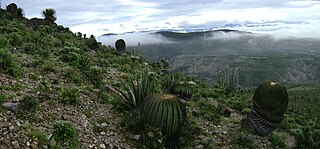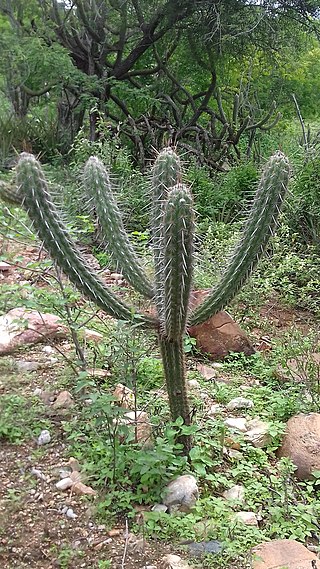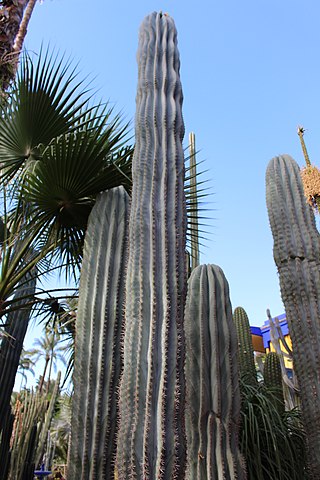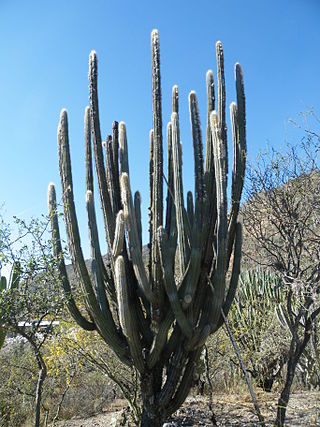
Cipocereus is a genus of cacti from Brazil. These species were previously included in the genera Pilosocereus and Cereus.

Pilosocereus is a genus of cactus native to the Neotropics. Tree cactus is a common name for Pilosocereus species. The genera Caerulocereus and Pseudopilocereus are synonyms of this genus.

3,4-Dimethoxyphenethylamine (DMPEA) is a chemical compound of the phenethylamine class. It is an analogue of the major human neurotransmitter dopamine where the 3- and 4-position hydroxy groups have been replaced with methoxy groups. It is also closely related to mescaline which is 3,4,5-trimethoxyphenethylamine.

Pilosocereus arrabidae is a species of plant in the family Cactaceae. It is endemic to Brazil. Its natural habitats are rocky shores and sandy shores. It is threatened by habitat loss.

Pilosocereus floccosus is a species of plant in the family Cactaceae. It is endemic to Brazil, in Bahia and Minas Gerais states. Its natural habitats are subtropical or tropical dry forests and rocky areas. It is threatened by habitat loss.

Pilosocereus multicostatus is a species of plant in the family Cactaceae. It is endemic to Brazil, in northern Minas Gerais state. Its natural habitat are rocky areas. It is threatened by habitat loss.

Pilosocereus royenii is a species of cactus found throughout the West Indies and the states of Yucatán and Quintana Roo in Mexico. Common names include Royen's tree cactus, dildo cactus, and pipe organ cactus. It is composed of multiple long, tubular shaped branches, each ribbed with multiple sections and sharp spines.

Cereus ( "serious") is a genus of cacti including around 33 species of large columnar cacti from South America. The name is derived from Greek (κηρός) and Latin words meaning "wax", "torch" or "candle". Cereus was one of the first cactus genera to be described; the circumscription varies depending on the authority. The term "cereus" is also sometimes used for a ceroid cactus, any cactus with a very elongated body, including columnar growth cacti and epiphytic cacti.

Pilosocereus robinii is a species of cactus known by the common name Key tree-cactus. It is native to the Florida Keys in the United States. It also occurs in Western Cuba and the Northern Bahamas. It has been erroneously reported from Puerto Rico, the Virgin Islands, and Mexico. It is a rare species which is threatened by the loss of its habitat. It is a federally listed endangered species of the United States.

The Tehuacán-Cuicatlán biosphere reserve is a protected natural area located in southeastern Mexico. Its name derives from its two main locations: Cuicatlán and Tehuacán, in the latter are their administrative offices, covers 490,186 hectares distributed among 21 municipalities in the state of Puebla and Oaxaca.

Pilosocereus catingicola is a flowering plant in the family Cactaceae that is endemic in northeastern Brazilian states of Rio Grande do Norte, Pernambuco, Alagoas, Sergipe, Paraíba, Bahia.

Pilosocereus leucocephalus, called old man cactus, old man of Mexico, tuno, and woolly torch, is a species of cactus in the genus Pilosocereus, native to Mexico and Central America. It has gained the Royal Horticultural Society's Award of Garden Merit. Pilosocereus leucocephalus functions as a keystone species in dry landscapes found in Mesoamerica. The fruit this cactus produces is relied upon as a source of hydration and sugar in arid areas by frugivores such as birds, bats, and even some reptiles.
Pilosocereus alensis, the Sonoran old man cactus, is a species of cactus native to Western Mexico, from Sonora south to Jalisco. The hairs protect the flower buds. Flowers open at night in June and give off the odor of ammonia, attracting bats for pollination. The juicy fruit is tasty.

Pilosocereus polygonus is a species of Pilosocereus found in Hispaniola.

Pilosocereus curtisii is a species of Pilosocereus found in the Lesser Antilles and the British Virgin Islands.

Pilosocereus chrysostele is a species of Pilosocereus found in Brazil

Pilosocereus bohlei is a species of Pilosocereus found in Bahia, Brazil

Pilosocereus machrisii is a species of Pilosocereus found in from West Bahia to Minas Gerais, Brazil

Pilosocereus pachycladus is a species of flowering plant in the family Cactaceae found in eastern Brazil, and introduced to the Canary Islands.

Pilosocereus chrysacanthus is a species of Pilosocereus found in Mexico to Honduras


















